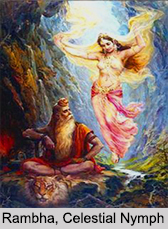 Rambha in Hindu myths is represented as the queen of the Apsarasas. She is the most beautiful, mesmerizing and the supernatural female beings in Devaloka.
Rambha in Hindu myths is represented as the queen of the Apsarasas. She is the most beautiful, mesmerizing and the supernatural female beings in Devaloka.
Rambha is an expert in the art of dancing, music and love-making. She is unparalleled in her talents.
Lord Indra, the king of the Devas time and again requested Rambha to break the tapasya or meditation of the sages so that the purity of their penance is tested against enticement. He also did so that the order of the three worlds remained uninterrupted by any one man`s supernatural powers.
Rambha was sent by Indra to seduce Rishi Vishwamitra. When Rambha tries to disturb the meditation of Rishi Vishwamitra she is cursed by him to become a rock for ten thousand years till a Brahmin delivers her from the curse.
In the Ramayana, Rambha was seen by is Ravana in Kailash. Ravana tried to humiliate her. Rambha warned him that she was the wife of Nalakuvara, son of his brother Kuvera. Ravana still dishonored her. He was then cursed by Brahma that if he violates another woman again then his head will burst. This curse protected the chastity of Sita, the wife of Rama when she is kidnapped by Ravana.
This article is a stub. You can enrich by adding more information to it. Send your Write Up to content@indianetzone.com




















